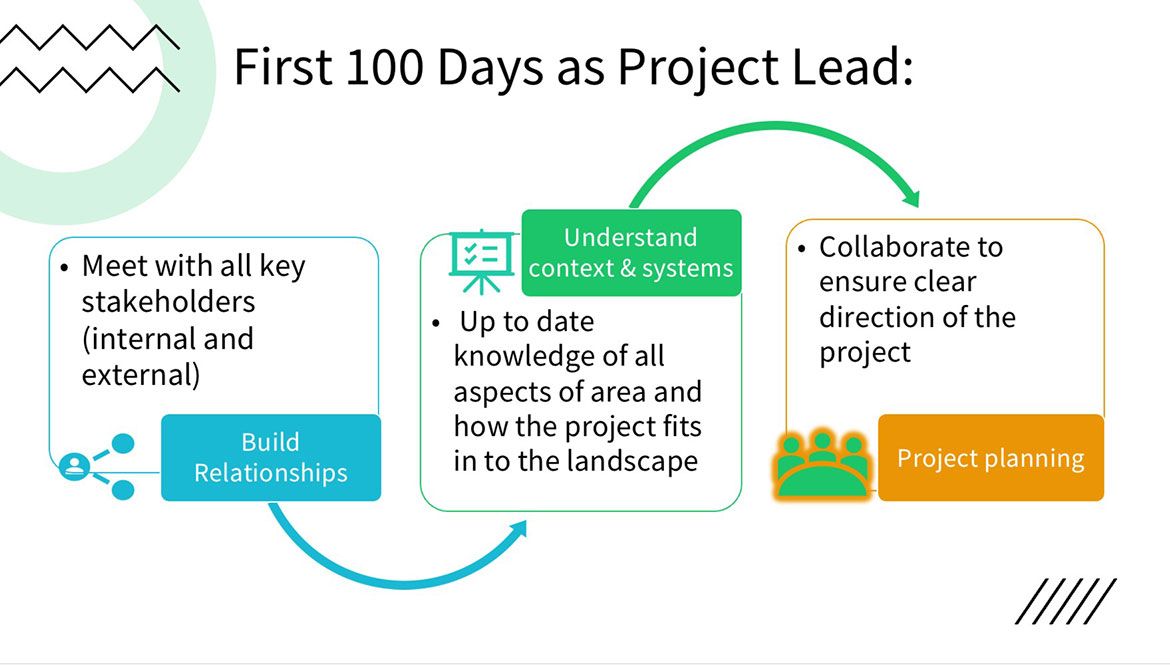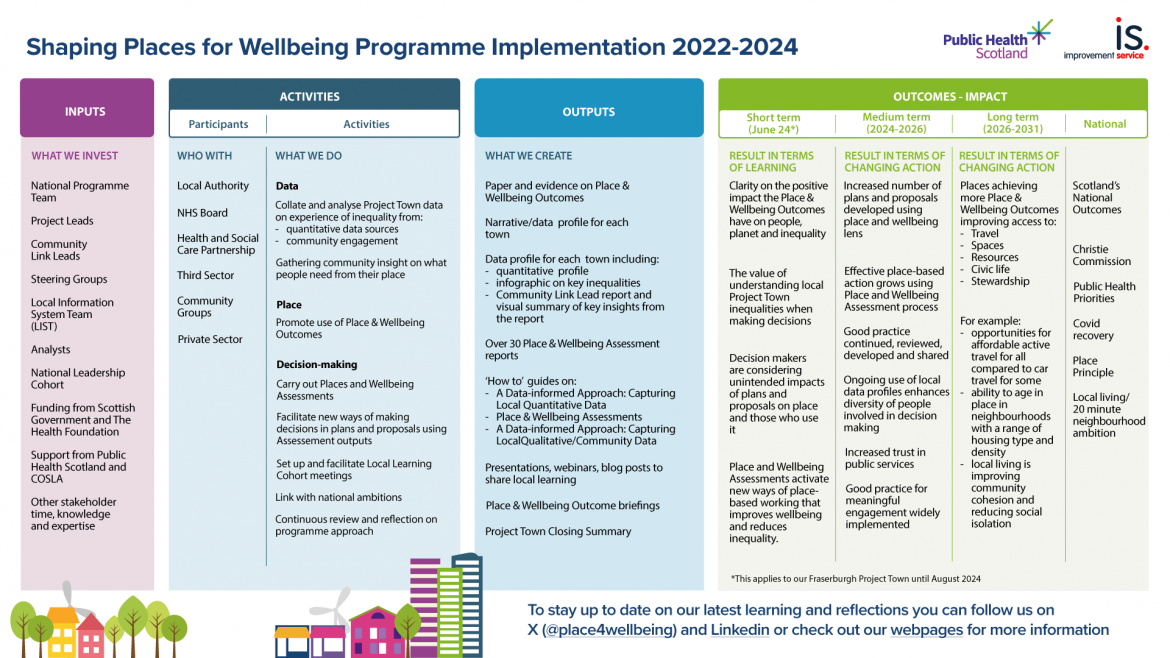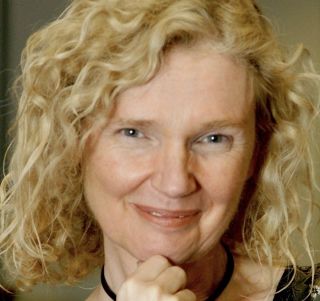Shaping our thinking... about the Shaping Places for Wellbeing Programme in Ayr.
Sharing our learning... about my first 100 days in post as Project Lead in Ayr.
Created by the Shaping Places for Wellbeing Programme Team. More information about the programme is at the end of this blog.
If you always do what you always did, you’ll get what you always got.
With Scotland’s life expectancy stalling and getting worse for those people living in the most deprived areas, can we afford to continue doing the same things over and over? Most people would say no, something needs to change! However, too often staff who could deliver systems change to improve outcomes for people, are often over worked and under staffed, meaning day to day ‘firefighting’ consumes their working lives. In order to implement change, it is important to make time and space for people to think about what could be done differently and who else could support this change for the better. The Shaping Places for Wellbeing Programme offers support to local project towns through the Project Lead role to facilitate the opportunity for people to come together to think, learn and plan in a different way.
During the first few months as Project Lead in Ayr I have started to see the opportunities the Shaping Places for Wellbeing Programme can offer through bringing together anchor organisations, services and communities to learn, sharing perspectives and work together using a place-based approach. In this blog I will outline what I have been doing since coming into post, what I have learned and the next steps as Project Lead for Ayr.
Starting a new job can be exciting and daunting. When it is a new programme there is an added element of uncertainty in relation to knowing where to start and what direction the work will move forward in. However, given that the Shaping Places for Wellbeing Programme is about encouraging a whole-systems approach and supporting systems change, the essential starting point was to begin by building relationships and understand the systems that exist and influence the project town.

- Build relationships: meet with all key stakeholders (internal and external).
- Understand context and systems: up to date knowledge of all aspects of area and how the project fits into the landscape.
- Project planning: collaborate to ensure clear direction of the project
People, Place and Papers
There have been three aspects to the process of fully understanding the complexities of systems and identifying opportunities to achieve the ambitions of the programme:
People
Taking the time to meet key people working across South Ayrshire Council, NHS Ayrshire and Arran and the third sector has been important to understand each person’s role within the systems they work and how they work in partnership with others. As well as raising awareness of the programme, I have had the time to listen to and be curious about their thoughts on the changes needed to improve health and reduce inequalities, the opportunities for better ways of working and how the programme could support bringing about change.
The Place and Wellbeing Outcomes outline the things that every place needs in order for people to stay healthy and thrive, I also used the five themes of movement, spaces, resources, civic and stewardship to identify key people to meet. Presenting at partnership meetings also enabled me to raise awareness of the programme across a number of partners.
Place
To fully understand the town, recognise the positive aspects, where improvements are needed and be aware of challenges experienced by people living there, it has been important to take regular walks around the project town. In particular, walking through the communities that have been identified through the data as experiencing the greatest inequalities has been extremely insightful and has helped to build a clearer picture of the issues and opportunities for improvement across the Place and Wellbeing Outcomes. Arranging walking meetings and listening to the people working in these areas has also been very valuable.
Papers
To complete the picture, I also spent time becoming familiar with the strategies, policies and plans that impact the project town. Using the Current and Future Ambitions work that was carried out by the programme team, I have been able to gain an overview of the policy context. From these ambitions, three or four strategies will be chosen by the Ayr Steering Group for the programme to support their development and hopefully influence local decision-making through Place and Wellbeing Assessments, which I will discuss later in this blog.
What I have come to understand is that the Shaping Places for Wellbeing Programme isn’t about implementing a specific intervention but providing opportunities for different perspectives to be shared and heard across and between organisations while ensuring the voices of people with personal knowledge and experience of a place is key within these discussions. The programme allows people to work with other departments or organisations that they currently might not recognise as being able to offer expertise and knowledge that will positively impact their area of work to ultimately bring about positive change and improve health outcomes for people.
Understanding the need for an upstream focus
With the cost of living crisis and poverty being acute and impacting the day-to-day lives of people right at this moment, it is understandable that longer-term preventative interventions can seem incongruous. Those working operationally with individuals experiencing real hardship want to be able to make a difference to people’s lives, right now. It is extremely important to recognise the positive change this can make for people and the great work taking place locally by many people. However, as Desmond Tutu once said, “There comes a point where we need to stop just pulling people out of the river. We need to go upstream and find out why they’re falling in.”
These upstream and downstream approaches do not need to be mutually exclusive; rather that individuals, staff, services and communities are working alongside each other gaining insights from each other to fully understand the reasons that people are falling in the river, and take a place-based approach to address these reasons.
Developing an implementation model with the aim to support understanding and clarity about what the project will deliver has been a process that has assisted my own thinking about the programme and my role as Project Lead.
The Shaping Places for Wellbeing Implementation Diagram, below, sets out the outputs and the short, medium- and long-term outcomes that the programme hopes to achieve. As can be seen from the diagram the positive impact of long-term preventative interventions lies beyond the timescale of the work, which runs until March 2024. However, it is hoped, that by raising awareness of the Place and Wellbeing Outcomes, testing out processes and sharing the learning of what has worked, this programme can be a catalyst for change. Processes and better collaboration can continue and grow long after the programme and hopefully, a longer-term change and improved outcomes can be realised.

Shaping Places for Wellbeing Implementation Diagram, which sets out the outputs and the short, medium- and long-term outcomes that the Shaping Places for Wellbeing Programme hopes to achieve. A PDF version of this image is available.
Going through this process has helped me to understand the complex landscape that we all work in and identify opportunities to influence change at a strategic level to make a positive impact on place and the day-to-day lives of people in Ayr. Systems are difficult to work in and change. However, having the time to understand how they interact and how many cross-cutting themes there are within and between organisations is useful. As a result, some key opportunities have been identified as areas for the programme to support.
It has been reassuring that there are already many factors working to make system change happen locally, with discussions underway to better align priorities and boundaries where partnerships work. Given recent years' events and current social issues, I feel that there is a palpable desire and enthusiasm across partners to work together and make a real difference to people’s lives, particularly for those in greatest need. It is my belief, that there is now greater awareness than ever about the wider social determinants of health and the importance of taking a collaborative approach to improving health and tackling health inequalities. COVID-19 laid bare and further deepened inequalities. However, it also presented opportunities for people to work better together and take different approaches to support communities due to the urgent nature of the crisis. It is important to build on the learning from that time and have honest conversations about moving forward with a whole-system approach and ensure people and place are at the centre of decision-making.
Throughout the first few months in post, I gained a greater understanding of the Place and Wellbeing Assessment process that is being used through the Shaping Places for Wellbeing Programme and the benefits it can offer local project towns to support these honest conversations. These assessments create the opportunity for a range of people across departments and organisations to come together to rapidly share their expertise and perspectives in relation to strategic decision-making while supporting a place-based approach to prevent and mitigate inequalities.
Using the Place and Wellbeing Outcomes as a basis for discussion, key stakeholders are asked to consider how the chosen strategy contributes positively to ‘place’ and prevents negative unintended consequences from occurring. Using the inequalities data gathered by Public Health Scotland’s Local Intelligence Support Team (LIST) this assessment process also ensures that those who are experiencing the greatest inequalities in Ayr are considered, and decisions being made do not widen the inequality gap but pay greater attention to actions that can improve the lives of people who need it most.
With increased understanding, I have been able to gather momentum and interest across partners to engage with this process. It will be interesting to see how the report produced following the assessments will influence decision-making and systems change. These reports will document the discussions that took place, and provide recommendations with associated evidence that if implemented could improve the health of people, planet and inequalities.
There is still a lot to learn about the systems that impact the town of Ayr and the inequalities faced by people within the town. Continued up-to-date knowledge of these systems will be an ongoing part of the role for the Project Lead. Unfortunately, I will not be in the role of Project Lead through to the end of the programme but hope I have laid the groundwork for continued success. It has been a difficult decision and I will be sad to leave but another opportunity arose which allows me to further my public health career. I have thoroughly enjoyed the role working with such a supportive team and I believe that the programme offers a great opportunity to support change. It has been said that the Place and Wellbeing Outcomes are very aspirational but I strongly believe we need to have an ambitious focus to strive for in order to achieve better outcomes for people, communities and places.
In order to continue learning and achieving the outcomes of the programme I believe the next steps should include:
- Continue to bring key partners and stakeholders together to carry out place and wellbeing outcome assessments on agreed strategies and action plans
- Focus on hearing more of the community voices and perspectives alongside the Community Link Lead, once recruitment is complete.
- Attend relevant partnership groups in order to continue to gain better understanding of systems and influence the place-based approach.
- Identify methods and opportunities to increase awareness of the Place and Wellbeing Outcomes with a wide audience and how they can be used to influence decision making.
- Gather stories to use storytelling as another way to describe how place can impact on the lives of individuals
- Continue to work on getting the right language to ensure all stakeholders fully understand the outcomes and ambition of the programme.
As part of the Shaping Places for Wellbeing Programme we aim to evaluate our work and share our learning across different key stages of the programme. One way we will share this is through the ‘Shaping our thinking, sharing our learning’ blog series.
Some key information about the programme:
- We are working to improve Scotland’s wellbeing by reducing the significant inequality in the health of its people while addressing the health of our planet
- The action is anchored in the Place and Wellbeing Outcomes
- The programme is coordinated and managed by a programme team from the Improvement Service and Public Health Scotland
- The programme runs until March 2024
- Programme has three key activities to support local activity:
- Local Project Towns (Ayr, Alloa, Clydebank, Dunoon, Fraserburgh and Rutherglen).
Each of the towns have a Steering Group made up of key partners - Local Learning Cohort
- National Leadership Cohort
- Local Project Towns (Ayr, Alloa, Clydebank, Dunoon, Fraserburgh and Rutherglen).
If you are looking at place-based approaches, or if the Shaping Places for Wellbeing Programme sounds like something you would like to know more about, please contact Irene Beautyman, Place and Wellbeing Partnership Lead, below or follow us on X (Twitter) @place4wellbeing to keep up to date with all of our latest news

Irene Beautyman - Place and Wellbeing Partnership Lead
Phone: 07908 930763
-
Shaping Places for Wellbeing Programme
The Shaping Places for Wellbeing Programme is a joint delivery partnership between the Improvement Service and Public Health Scotland. This forum is for those interested in our work supporting the role of place to reduce inequality and improve the wellbeing of people and planet.
-
Place Network
For those interested in the importance of place as a working approach to delivering national outcomes around improved wellbeing and inclusive growth.